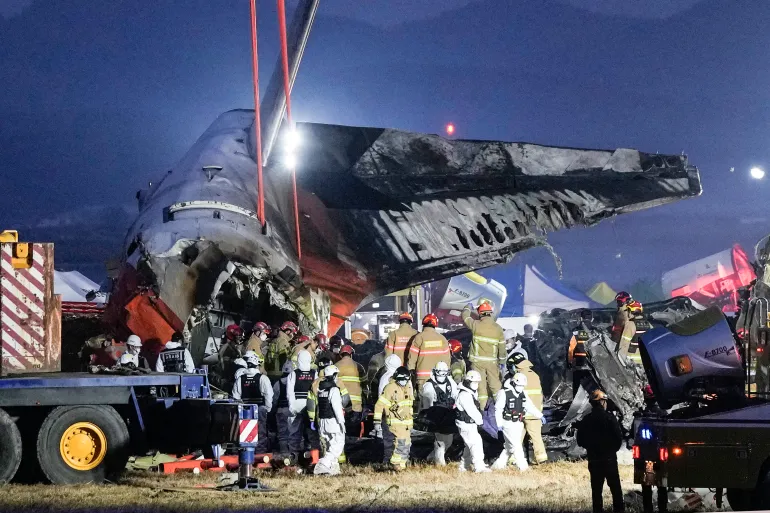A Jeju Air flight from Bangkok to South Korea, carrying 181 people, tragically crashed during its landing on Sunday, resulting in the deaths of 179 passengers and crew members. Only two survivors were rescued from the wreckage.
The Boeing 737-800, operated by the budget airline Jeju Air, had departed from Bangkok at 9:00 AM (0000 GMT) and was approaching Muan airport when it was warned of a potential bird strike during its first landing attempt. Moments later, the pilot declared a “mayday” and attempted a second landing. Video footage showed the plane attempting a belly landing with its landing gear still retracted. The aircraft skidded along the runway, trailing smoke, before crashing into a wall at the end of the runway and bursting into flames.
The crash claimed the lives of all 175 passengers and four of the six crew members on board. The passengers, aged 3 to 78, were mostly South Korean, with two Thai nationals among them. Rescue teams managed to pull two survivors—two flight attendants, aged 25 and 33—from the wreckage.
What Caused the Accident?
Authorities have launched an investigation into the cause of the crash, with a bird strike and adverse weather conditions being considered as possible factors.
Philip Butterworth-Hayes, an aviation consultant, explained that the scale of the tragedy likely resulted from a series of catastrophic events. “It really has to be a combination of factors that led to such a high loss of life,” he said, noting that modern crash protection systems on board aircraft are designed to be extremely robust. He called the incident “the most serious I’ve seen in recent years.”
When questioned about the possibility of the runway being too short, an official dismissed this as unlikely, noting that the runway was 2,800 meters (9,200 feet) long—ample for similar-sized aircraft.
Both of the aircraft’s black boxes—the flight data recorder and the cockpit voice recorder—have been recovered, according to South Korea’s Deputy Transport Minister, Joo Jong-wan.
What is a Bird Strike?
A bird strike refers to a collision between a bird and an aircraft in flight. Such incidents can be hazardous, especially if birds are ingested into the engines, causing a loss of power. The International Civil Aviation Organization (ICAO), a UN agency, has highlighted bird strikes as a serious threat to aircraft safety.
While bird strikes are rare, they can have devastating consequences. Butterworth-Hayes pointed to the famous “Miracle on the Hudson” incident in 2009, when a US Airways Airbus A320 struck a flock of birds shortly after takeoff, damaging both engines. The crew successfully managed an emergency ditching in the Hudson River, saving all aboard.
Experts believe that this crash could have been caused by large birds hitting the aircraft’s engine, though such occurrences are extremely rare.
Rescue and Response
Following the crash, hundreds of emergency responders, including firefighters and military personnel, were deployed to Muan airport. South Korea’s acting president declared the area a special disaster zone. Family members of the victims, many in tears, anxiously awaited information in the airport terminal.
Government’s Response
The accident occurred amid a political crisis in South Korea, following the controversial declaration of martial law by then-President Yoon Suk Yeol on December 3, shortly before his impeachment. On his third day in office, acting President Choi Sang-mok convened an emergency cabinet meeting and personally visited the crash site to oversee the response.






